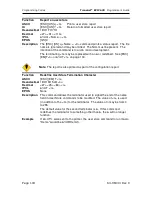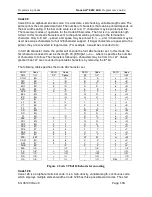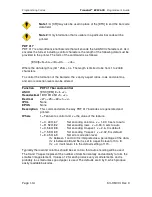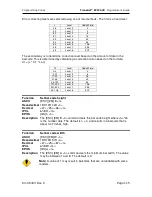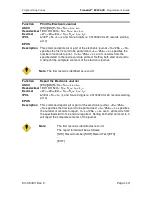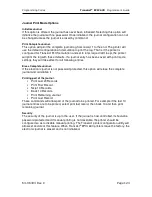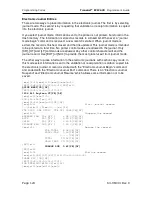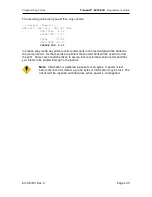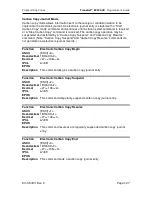
&&
&
'
&&
8 ,
!!
UPC A
UPC A is a fixed-length, numeric, continuous code that employs four element widths.
The printer supports Universal Product Code Version A, E, EAN-8, and EAN-13. Version
A encodes 11 digits. Typically, the UPC A format starts with a number system digit, five-
digit manufacturer’s code, five-digit product code, and a check digit. The printer makes
no assumptions about any of the codes except the check digit. The printer prints an UPC
bar code with the 11 digits sent to it and generates the check digit. If fewer than 11 digits
are sent, the remaining digits will be zeros. The printer prints an UPC that is about 130%
the size of the UPC nominal standard, which provides optimal readability.
UPC E
UPC E is a zero suppression version of UPC. The printer requires that the first digit is
zero for number system zero. If it is not zero, the bar code is not printed. The printer
does the compression based on the compression rules for UPC E, prints an UPC bar
code based on the 11 digits sent to it, and generates the check digit. If fewer than 11
digits are sent, the remaining digits will be zeros. The printer prints an UPC that is about
130% the size of the UPC nominal standard, which provides optimal readability.
EAN-13
EAN-13 is a fixed-length, numeric, continuous code that employs four element widths.
The printer supports EAN-13, which is a superset of UPC that encodes 12 digits.
Typically, the format starts with a number set digit, which defines how the next six digits
are encoded. The next five digits have fixed encoding. The last is a check digit. The
printer prints an EAN-13 bar code with the 12 digits sent to it and generates the check
digit. If fewer than 12 digits are sent, the remaining digits will be zeros. The printer prints
an EAN-13 bar code that is about 130% the size of the nominal standard, which provides
optimal readability.
EAN-8
EAN-8 is a fixed-length, numeric, continuous code that employs four element widths.
The printer supports EAN-8, which is a superset of UPC that encodes seven digits. The
printer prints an EAN-8 bar code with the seven digits sent to it and generates the check
digit. If fewer than seven digits are sent, the remaining digits will be zeros. The printer
prints an EAN-8 bar code that is about 130% the size of the nominal standard, which
provides optimal readability.
EAN-14
EAN-14 It is a high-density, fixed-length, numeric, continuous code, which employs
multiple element widths. EAN-14, is a subset of Code 128 that encodes FNC1 and 14
digit pairs. If fewer than 14 digits are sent, leading zeros will be added to complete the
code.
Code 93
Code 93 is a variable-length, alphanumeric bar code. The complete data field is printed
by the printer. Due to space limitations, only 10 characters can be printed.
Codabar
Codabar is a variable-length format, primarily used for numeric symbols. It offers 16 data
characters, including the numeric digits zero through nine, and -, $, :, /, ., and +. Four
unique start/stop characters, designated A, B, C, and D, are also available. Due to space
limitations, only 12 characters can be printed.
Summary of Contents for EPIC 630
Page 1: ......
Page 9: ......
Page 10: ...This page intentionally left blank...
Page 16: ...4 7 8 5 This page intentionally left blank...
Page 17: ......
Page 18: ...This page intentionally left blank...
Page 30: ......
Page 31: ...This page intentionally left blank...
Page 37: ......
Page 38: ...This page intentionally left blank...
Page 41: ......
Page 42: ...This page intentionally left blank...
Page 57: ...8...
Page 162: ...8 5 1...
Page 163: ...8 This page intentionally left blank...
Page 173: ...8 This page intentionally left blank...
Page 174: ......
Page 175: ......
Page 176: ...5 This page intentionally left blank...
Page 179: ...5 0 1...
Page 180: ...This page intentionally left blank...
Page 194: ......
Page 196: ......






